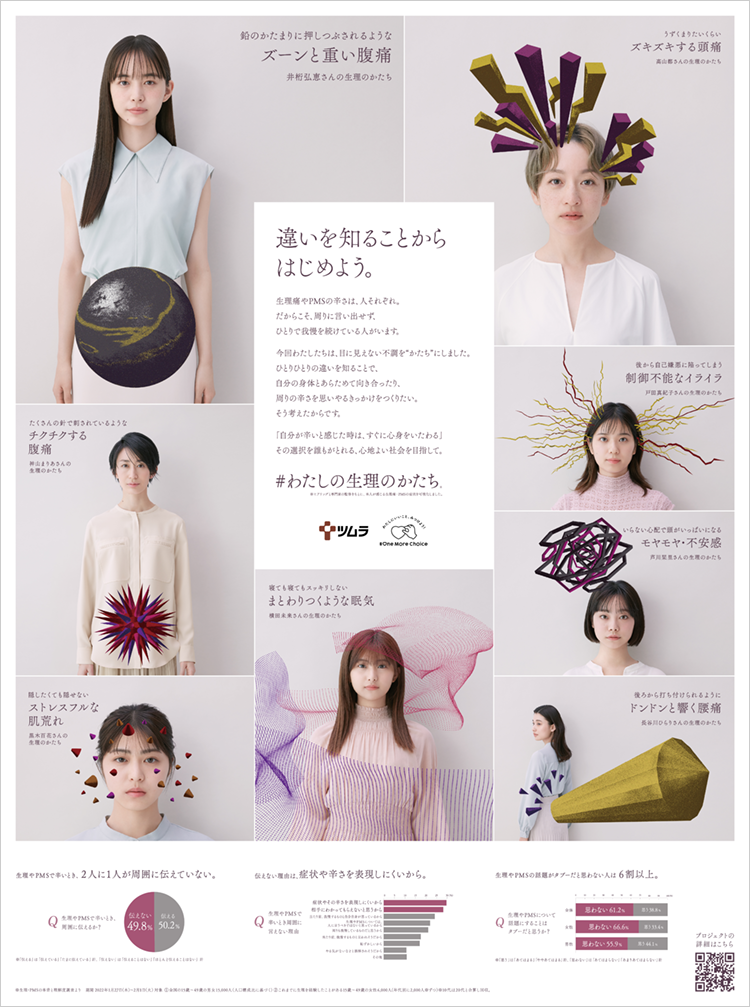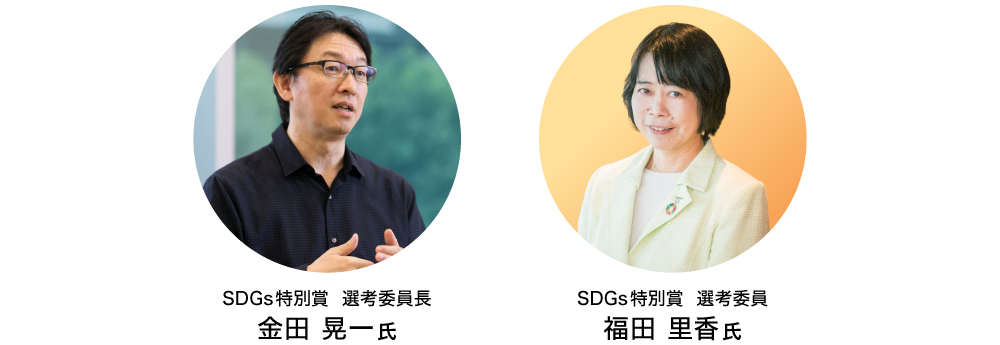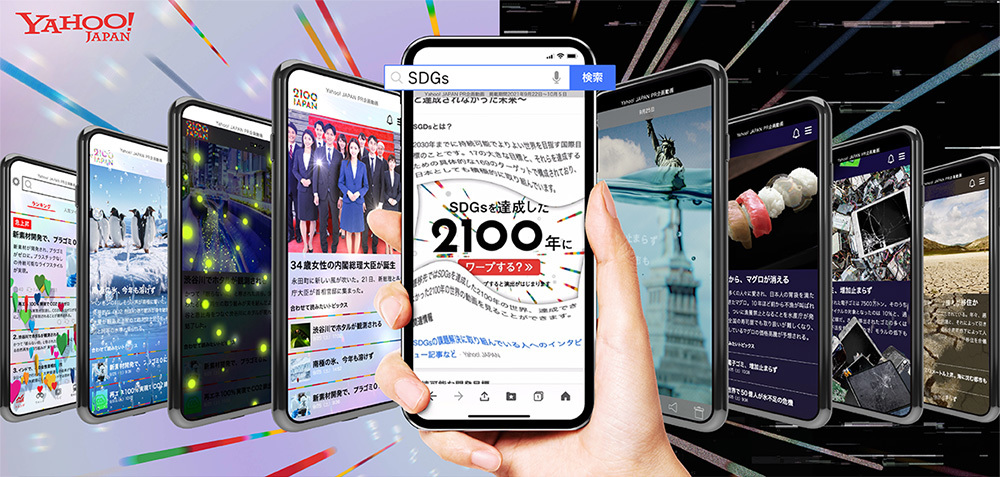
This year marks the ninth year since the SDGs were adopted in 2015. We have reached the midpoint of the period leading up to the 2030 target date. How are advertisements conveying corporate messages and initiatives evolving to achieve the SDGs and realize a sustainable society?
This article presents a dialogue between Koichi Kaneda, Chair of the Selection Committee for the 75th Dentsu Inc. Advertising Awards SDGs Special Prize, and Rika Fukuda, a member of the Selection Committee. The two reflected on the submitted entries while exchanging views on recent advertising communication trends.

Koichi Kaneda: Senior Specialist, Sustainability Management Promotion Department, NTT DATA. With over 20 years in sustainability, he currently works at NTT DATA to advance sustainability management in collaboration with stakeholders.
Rika Fukuda: Head of CSR and Corporate Citizenship Activities, Panasonic Holdings. Leads diverse initiatives toward a sustainable coexistence society, including educational support for children, delivering electricity and lighting to off-grid areas, and providing sustainable seafood in employee cafeterias for environmental conservation. Actively communicates the significance and purpose of corporate citizenship activities while striving to enhance brand and corporate value through CSR and corporate citizenship efforts.
Societal changes have become "personal matters," and advertising communication is evolving accordingly
──How do you feel corporate advertising communication has changed post-pandemic in pursuit of achieving the SDGs and realizing a sustainable society?
Kaneda: Over the past few years, significant societal shifts—notably pronounced climate change, the COVID-19 pandemic, and the Ukraine crisis—have profoundly impacted our lives and corporate actions. These changes have become more personally relevant, fostering a growing sense of "myself within society" and "the company within society," rather than viewing "me" and "society" as separate entities.
This shift has influenced advertising expression, leading to a surge in messaging about "the purpose of a company's existence within society." One example is the approach of contributing to a sustainable society through core business activities, such as products and services that embody the company's strengths.
However, approaches to demonstrating a company's purpose extend beyond core business. They include communications through corporate citizenship activities like donations and employee volunteer programs, messages from top executives or individual employees, and even evaluation comments from partner NPOs/NGOs. This diversity in how companies connect with society is reflected in advertising.
Fukuda: Regarding communications from our corporate citizenship activities, we share details of our initiatives, including their significance and purpose, both internally and externally. What we consider crucial is that "communication isn't the end goal." We believe it doesn't truly count as effective communication unless it moves the hearts of the recipients. We are constantly exploring how to convey our message without it becoming self-congratulatory. By communicating accurately and fostering empathy, we believe this leads to enhancing brand value and corporate value.
"Visualization," "Future," "Technology": Three Keywords Emerging from the 75th Edition Submissions
──This is your third year serving as a judge for the SDGs Special Award at the Advertising Dentsu Inc. Awards. Could you share any changes compared to previous years and the characteristics of the entries?
Kaneda: In 2020, when the SDGs Special Award was introduced to the Dentsu Inc. Advertising Awards, many entries focused on simply presenting social issues themselves. However, with each passing year, I feel the entries have gradually shifted towards advertising that proposes concrete solutions to social issues or encourages behavioral change.
They present the social issue while also stating, "Our products and services will solve this social issue," thereby promoting the company's sustainability. I get the impression that more ads are achieving a balance between social value and corporate value. Furthermore, among this year's entries, the ones highly rated by the selection committee seemed to have three keywords: "visualization," "future," and "technology."
Among them, the Tsumura advertisement that won an award this time, "Start by learning about the differences. #MyPeriodShape," was highly praised by the committee for its visualization of pain—something invisible—in various forms.

Visit the "Start by Understanding Differences. #MyPeriodShape" site
here.
Fukuda: I also found Tsumura's ad interesting for how it visualized invisible pain and hardship through diverse designs. It's also good that, despite addressing an SDGs-related issue, it doesn't aggressively push the "SDGs ad" angle. I feel SDGs are becoming more familiar in our daily lives, and sustainability advertising is evolving too.
Kaneda: While Tsumura's ad visualized through "form," there were also ads like Mizkan's that visualized issues using "numbers." For example, cooking recipes often list quantities as "one-third" or "one-half," which also means "two-thirds" or "one-half" of the ingredients are left over. Mizkan focused on this and proposed recipes using leftover ingredients as "B-side recipes." It's fascinating how visualization can take so many different forms, isn't it?

The "B-side Recipes" site is
here.
Fukuda: Mitsukan's ad was one that really caught my attention too. The fraction notation is clear and interesting, and their approach of tackling the major social issue of food loss in a fun way is great. Since cooking is part of daily life, it makes the audience feel like they can easily give it a try, leading to behavioral change.
Kaneda: Komatsu's ad impressively visualized the future with the message "This is the society coming next," using cutting-edge technology. Showing the actual operation – like smoothly controlling massive heavy machinery with a game controller – creates real persuasive power. It gave me hope that such scenes could soon be seen worldwide.

The "Concept: Future Worksites" site is
here.
Fukuda: I appreciated how clearly they defined the challenge—"making tough, demanding work sustainable and manageable"—and then concretely showed the solutions to achieve it. Furthermore, using something children are familiar with, like a game controller, to appeal to "future workers" is brilliant.
Kaneda: Yahoo's ad visualized the future through a different approach than Komatsu. Showing both a future where SDGs were achieved and one where they weren't, then asking "Which future is better?" – that presentation was truly impressive. It backcasts and asks, "So, what should we do now?" It serves as a catalyst to shift people's awareness about SDGs.

Yahoo! JAPAN "2100JAPAN". On the special project page, you can experience "a world where the SDGs were achieved in 2100" and "a world where the SDGs were not achieved in 2100" through immersive videos.
Fukuda: When you search for SDGs-related terms, your phone gets hijacked and takes you to a video titled "2100JAPAN." I thought it was an impactful ad, very Yahoo-like. While selecting entries this time, I focused on whether they could trigger recipients to change their daily actions. Among the criteria, "impact size" was definitely a key point.
For example, simply being told to take action for the environment makes it hard to visualize specific problems or feel personally invested. But seeing footage of ice melting rapidly in Antarctica alone should make you feel, "Something terrible is happening, we have to do something."
Conversely, unless people are shocked or think "Wow!", their behavior rarely changes. That's why I believe impactful ads that stir the heart can be a major catalyst for changing everyday actions.
However, ads with major impact also carry risks and fears. Because of their significant influence, if they convey incorrect information or use misleading expressions, this can affect the actions of the audience. Considering this, I felt the responsibility on the side of those creating ads is immense, and we are entering an era where their integrity is being tested.
Approaches that incorporate "humor" and "charm" to strike an emotional chord are also necessary
──How do you think corporate sustainability advertising will evolve going forward?
Kaneda: I think Japanese corporate sustainability ads could use more humor. Among the entries this time, the one that really stood out to me for its delightful humor and warmth was Nippon Ham's "Shawesson Haircut Ceremony."

The "Shawesson Haircut Ceremony" site is
here.
This ad playfully refers to cutting the drawstring part of the film packaging as a "hair-cutting ceremony," conveying the transformation into an environmentally conscious package in a way that makes you chuckle.
The homepage video, supervised by the Japan Sumo Association, seriously recreates a hair-cutting ceremony. It's memorable, so every time I go to the supermarket, I think, "Maybe I'll buy Schauessen," or compare it to other brands' packaging. Honestly, I do that at the supermarket (laugh).
SDGs often get perceived as overly serious, which limits advertising approaches. We could use more campaigns like Schauessen's that hook you on a different emotional level.
Furthermore, ads that actively involve or engage the audience are still relatively rare among Japanese companies. Some global corporations, even aware of the risks and potential backlash from such engagement, will take the plunge if they feel secure in their strong base of supporters. For these companies, this very approach to advertising has become part of their brand identity.
Furthermore, I feel that "charm," distinct from "humor," is also a concept that shouldn't be underestimated. This came to mind when I rejoined Sony and, as a first-year student at Sony University, was considering internal proposals related to CSR. During a lecture, an executive explained charm using the example of a grandchild.
For example, imagine a family spending their holiday in separate rooms. What happens when a grandchild suddenly visits? Family members start coming out of their rooms one by one, naturally gathering in the grandchild's room. Not out of obligation or reluctance, but because they genuinely want to "do something for them" or "play together" – they just go to see them.
"A company stakeholders can't ignore." This offers a different perspective from humor, doesn't it? I'm now extending this thought to ponder, "What makes an advertisement charming?"













